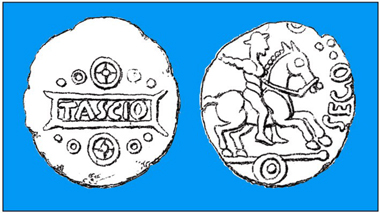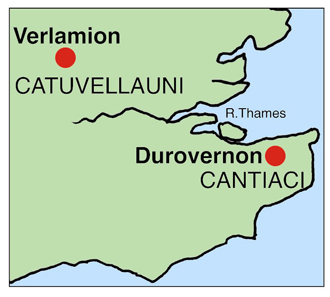by Chris Rudd
On 20 December 2012 an exceedingly rare gold coin of the Cantiaci tribe was found south of Canterbury in Kent. The coin is a gold quarter stater attributed to Sego, an elusive king who probably ruled in east Kent shortly after the birth of Christ (the discovery of the coin, five days before Christmas Day, was well timed).
Sego gold stater (ABC 441) first published 1848. The obverse is so like the quarter stater that both must be part of the same royal coinage, the same royal family. Sir John Evans (1823-1908) thought so too. Source: F. W. Fairholt, 1864/EC.
Besides this finding, only two other examples are recorded by the Celtic Coin Index: one in a private collection, possibly found around ten years ago; the other in the British Museum, found over 123 years ago. The recent Canterbury coin is important because it is the only one with a reliably reported findspot – a valuable asset when trying to ascertain the territory of the ruler who issued it. It is also one of the finest specimens known and will be offered for sale in early May.
Sego gold quarter stater (ABC 444), struck for use in Kent c.AD 5-15, found south of Canterbury, 20.12.2012. Only two others recorded by CCI. Tascio means ‘badger’. To be sold by Chris Rudd, 7.5.2013. Source: Finder (Badger): Sergio.
It has been suggested that Sego never existed as a person and that Tasciovanos (‘killer of badgers’) described himself as sego (‘the victorious’) on some of his Cantian coins to celebrate a military victory in Kent. I think this is highly unlikely for three reasons:
- Sego is well attested as the first part of several personal names.
- There is no precedent in ancient British coinage – not one – for the word sego, or any other such adjective, being used on a coin, particularly when no other inscription is present (as is the case with the two silver coins of Sego, ABC 447 and 450).
- Why would Tasciovanos of Hertfordshire issue coins in a ‘foreign’ land (Kent), where he wasn’t so well known, without putting his name on them? It just doesn’t make sense.
noneIt has been suggested that Sego never existed as a person and that Tasciovanos (‘killer of badgers’) described himself as sego (‘the victorious’) on some of his Cantian coins to celebrate a military victory in Kent. I think this is highly unlikely for three reasons:
* Sego is well attested as the first part of several personal names.
* There is no precedent in ancient British coinage – not one – for the word sego, or any other such adjective, being used on a coin, particularly when no other inscription is present (as is the case with the two silver coins of Sego, ABC 447 and 450).
* Why would Tasciovanos of Hertfordshire issue coins in a ‘foreign’ land (Kent), where he wasn’t so well known, without putting his name on them? It just doesn’t make sense.
I think that Tasciovanos, high king of the Catuvellauni, pointed Sego (a son?) to rule the eastern Cantiaci on his behalf. The recent discovery of a Sego gold quarter stater in east Kent seems to support this idea. Source: Chris Rudd.
So, if Sego isn’t an epithet, what was he? In my opinion, all the evidence points to Sego being a powerful prince in Kent who ruled the eastern part of the Cantiaci on behalf of Tasciovanos, high king of the Catuvellauni, who lived north of the Thames and whose capital was at Verlamion (St Albans, Herts), more than fifty miles from Durovernon (Canterbury), capital of the Cantiaci. I think that Tasciovanos lived too far from east Kent to govern it effectively himself. My guess is that he appointed one of his sons – one called Sego – to rule his newly won territory in Kent for him. All the coins of Sego – gold, silver and bronze – are so similar to those of Tasciovanos that I believe they must have come from the same royal family.
For more information on Chris Rudd or if you are interested in the up-coming auction please click here.








